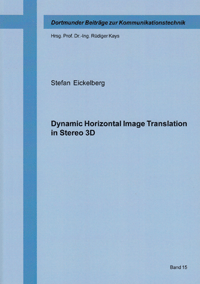
Shop : Details
Shop
Details

July 2017
Stefan Eickelberg
Dynamic Horizontal Image Translation in Stereo 3D
Dynamic horizontal image translation (DHIT) denotes the act of dynamically shifting the stereo 3D (S3D) views of a scene in opposite directions so that the portrayed scene is moved along the depth axis. This technique is predominantly used in the context of active depth cuts, where the shifting occurs just before and after a shot cut in order to mitigate depth discontinuities that would otherwise induce visual fatigue.
In this work, the perceptual properties of the DHIT are investigated experimentally. An important finding was that there are strong individual differences in the sensitivity towards DHIT. Furthermore, two enhancements of this approach are proposed and analyzed.
When a DHIT is performed, the presented scene depth is distorted, i.e., compressed or stretched. A distortion-free dynamic horizontal image translation (DHIT+) is proposed that mitigates these distortions by adjusting the distance between the S3D cameras through depth-image-based rendering techniques. This approach proved to be significantly less annoying. The views could be shifted about 50% faster without perceptual side effects.
Another proposed approach is called gaze adaptive convergence in stereo 3D applications (GACS3D). An eye tracker is used to estimate the visual focus whose disparity is then slowly reduced using the DHIT. In order to be able to do so, a high accuracy 3D visual focus estimation has been developed. GACS3D is supposed to lessen visual fatigue since the infamous accommodation vergence discrepancy is reduced.
In this work, the perceptual properties of the DHIT are investigated experimentally. An important finding was that there are strong individual differences in the sensitivity towards DHIT. Furthermore, two enhancements of this approach are proposed and analyzed.
When a DHIT is performed, the presented scene depth is distorted, i.e., compressed or stretched. A distortion-free dynamic horizontal image translation (DHIT+) is proposed that mitigates these distortions by adjusting the distance between the S3D cameras through depth-image-based rendering techniques. This approach proved to be significantly less annoying. The views could be shifted about 50% faster without perceptual side effects.
Another proposed approach is called gaze adaptive convergence in stereo 3D applications (GACS3D). An eye tracker is used to estimate the visual focus whose disparity is then slowly reduced using the DHIT. In order to be able to do so, a high accuracy 3D visual focus estimation has been developed. GACS3D is supposed to lessen visual fatigue since the infamous accommodation vergence discrepancy is reduced.
Keywords: Stereo 3D; Visual Discomfort; Visual Fatigue; Dynamic Horizontal Image Translation; Eye Tracking; Dynamic Camera Baseline
Dortmunder Beiträge zur Kommunikationstechnik
Edited by Prof. Dr.-Ing. Rüdiger Kays, Dortmund
Volume 15
Available online documents for this title
DOI 10.2370/9783844053616
You need Adobe Reader, to view these files. Here you will find a little help and information for downloading the PDF files.
Please note that the online documents cannot be printed or edited.
Please also see further information at: Help and Information.
Please also see further information at: Help and Information.
| Document |  | Document | ||
| Type |  | |||
| Costs |  | 36,60 € | ||
| Action |  | Purchase in obligation and download the file | ||
| Document |  | Table of contents | ||
| Type |  | |||
| Costs |  | free | ||
| Action |  | Download the file | ||
User settings for registered online customers (online documents)
You can change your address details here and access documents you have already ordered.
User
Not logged in
Export of bibliographic data
Shaker Verlag GmbH
Am Langen Graben 15a
52353 Düren
Germany
Am Langen Graben 15a
52353 Düren
Germany
Mon. - Thurs. 8:00 a.m. to 4:00 p.m.
Fri. 8:00 a.m. to 3:00 p.m.
Fri. 8:00 a.m. to 3:00 p.m.
Contact us. We will be happy to help you.

